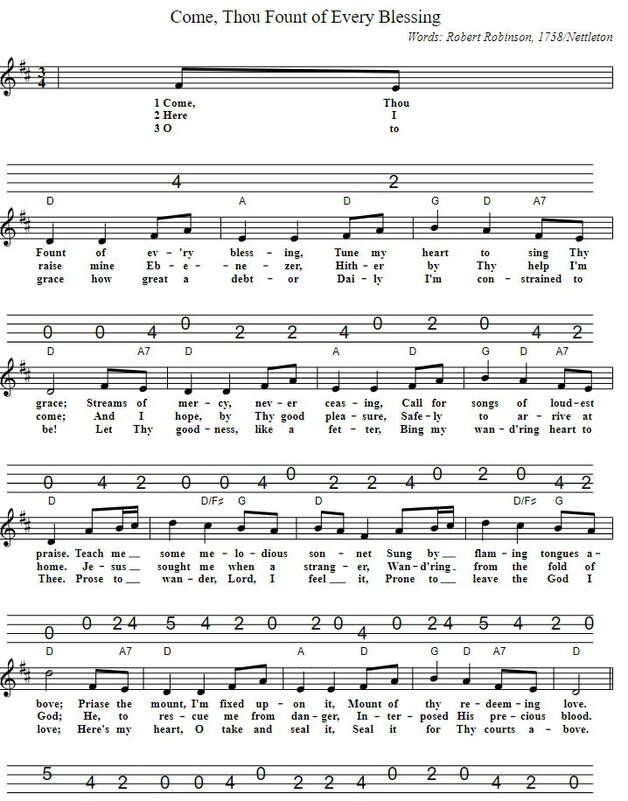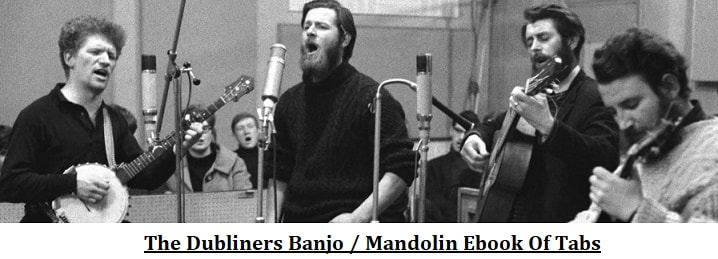Come Thou Font Of Every Blessing Sheet Music For Mandolin
Come Thou Font Of Every Blessing Sheet Music Lyrics and Chords For Mandolin in the key of D Major. A Traditional Hymn that's still popular and still being recorded today by the top singers.
Below is the list of songs [ tabs ] included in the Mandolin ebooks. The price is €7.90
and I'll email the download links after payment. Standard tuning GDAE,
You'll receive every song listed below which is around 600 and a mix of folk, ballads, pop and rock.
Now including a free Beatles ebook of songs and another of Irish rebel songs plus Christmas songs and hymns.
Also included is a 500 page ebook of lyrics and chords for the mandolin / tenor banjo in 3 different easy keys.
Martin
and I'll email the download links after payment. Standard tuning GDAE,
You'll receive every song listed below which is around 600 and a mix of folk, ballads, pop and rock.
Now including a free Beatles ebook of songs and another of Irish rebel songs plus Christmas songs and hymns.
Also included is a 500 page ebook of lyrics and chords for the mandolin / tenor banjo in 3 different easy keys.
Martin
Introduction:
Music has always been an integral part of human society and has served as a medium for expressing one's emotions, beliefs, and values. One such musical piece that has stood the test of time and has been cherished by many is the hymn 'Come Thou Font Of Every Blessing'. This hymn, written by Robert Robinson in the 18th century, has become a cornerstone of Christian worship and has been sung in churches and gatherings around the world. Its enduring popularity can be attributed to its timeless message and its ability to resonate with people from all walks of life. In this thesis, we will explore the history, significance, and impact of the hymn 'Come Thou Font Of Every Blessing'.
History of the hymn:
The hymn 'Come Thou Font Of Every Blessing' was written by Robert Robinson in 1757. Robinson was a prolific writer and theologian, who was deeply influenced by the Methodist movement in England. He wrote this hymn at the age of 22, and it was first published in his collection of hymns titled 'A Collection of Hymns Used by the Church of Christ in Angel Alley, Bishopgate'. The hymn was set to the tune 'Nettleton' by John Wyeth, which is still used today.
Significance of the hymn:
The hymn 'Come Thou Font Of Every Blessing' is a powerful expression of faith and thanksgiving. It is based on the biblical passage from 1 Samuel 7:12, which says, 'Then Samuel took a stone, and set it between Mizpah and Shen, and called the name of it Ebenezer, saying, Hitherto hath the Lord helped us'. This passage signifies the Israelites' acknowledgement of God's faithfulness and provision in their lives. Similarly, the hymn encourages believers to reflect on the blessings of God and give thanks for them.
The first line of the hymn, 'Come Thou Font of every blessing', refers to God as the source of all blessings. It is a reminder that everything we have comes from God and not from our own efforts. The use of the word 'font' also has a deep significance as it refers to a source of water, which is essential for life. In this context, it represents God as the source of spiritual nourishment and sustenance.
The hymn also acknowledges the human struggle with sin and the need for God's grace and forgiveness. The lines 'Prone to wander, Lord, I feel it / Prone to leave the God I love' speak to the human tendency to stray from God and the constant need for His guidance and mercy. This message is relevant even today, as people continue to struggle with their faith and face challenges in their spiritual journey.
Impact of the hymn:
Over the years, 'Come Thou Font Of Every Blessing' has become one of the most beloved and influential hymns in the Christian community. Its timeless message and beautiful melody have touched the hearts of people from different generations and backgrounds. The hymn has been translated into many languages and has been sung in churches, revivals, and missionary gatherings around the world.
Moreover, the hymn has also inspired many other artists to create their own versions of it. In the 20th century, American composer and arranger Mack Wilberg created a choral arrangement of the hymn, which has been performed by the renowned Mormon Tabernacle Choir. The hymn has also been featured in several films and TV shows, further cementing its place in popular culture.
Conclusion:
In conclusion, 'Come Thou Font Of Every Blessing' is more than just a hymn; it is a powerful expression of faith, gratitude, and hope. Its timeless message of God's faithfulness and provision continues to resonate with people today, making it a staple in Christian worship. The hymn's enduring popularity and impact on people's lives is a testament to its beauty and significance. It has stood the test of time and will continue to be an important part of Christian worship for generations to come.
Music has always been an integral part of human society and has served as a medium for expressing one's emotions, beliefs, and values. One such musical piece that has stood the test of time and has been cherished by many is the hymn 'Come Thou Font Of Every Blessing'. This hymn, written by Robert Robinson in the 18th century, has become a cornerstone of Christian worship and has been sung in churches and gatherings around the world. Its enduring popularity can be attributed to its timeless message and its ability to resonate with people from all walks of life. In this thesis, we will explore the history, significance, and impact of the hymn 'Come Thou Font Of Every Blessing'.
History of the hymn:
The hymn 'Come Thou Font Of Every Blessing' was written by Robert Robinson in 1757. Robinson was a prolific writer and theologian, who was deeply influenced by the Methodist movement in England. He wrote this hymn at the age of 22, and it was first published in his collection of hymns titled 'A Collection of Hymns Used by the Church of Christ in Angel Alley, Bishopgate'. The hymn was set to the tune 'Nettleton' by John Wyeth, which is still used today.
Significance of the hymn:
The hymn 'Come Thou Font Of Every Blessing' is a powerful expression of faith and thanksgiving. It is based on the biblical passage from 1 Samuel 7:12, which says, 'Then Samuel took a stone, and set it between Mizpah and Shen, and called the name of it Ebenezer, saying, Hitherto hath the Lord helped us'. This passage signifies the Israelites' acknowledgement of God's faithfulness and provision in their lives. Similarly, the hymn encourages believers to reflect on the blessings of God and give thanks for them.
The first line of the hymn, 'Come Thou Font of every blessing', refers to God as the source of all blessings. It is a reminder that everything we have comes from God and not from our own efforts. The use of the word 'font' also has a deep significance as it refers to a source of water, which is essential for life. In this context, it represents God as the source of spiritual nourishment and sustenance.
The hymn also acknowledges the human struggle with sin and the need for God's grace and forgiveness. The lines 'Prone to wander, Lord, I feel it / Prone to leave the God I love' speak to the human tendency to stray from God and the constant need for His guidance and mercy. This message is relevant even today, as people continue to struggle with their faith and face challenges in their spiritual journey.
Impact of the hymn:
Over the years, 'Come Thou Font Of Every Blessing' has become one of the most beloved and influential hymns in the Christian community. Its timeless message and beautiful melody have touched the hearts of people from different generations and backgrounds. The hymn has been translated into many languages and has been sung in churches, revivals, and missionary gatherings around the world.
Moreover, the hymn has also inspired many other artists to create their own versions of it. In the 20th century, American composer and arranger Mack Wilberg created a choral arrangement of the hymn, which has been performed by the renowned Mormon Tabernacle Choir. The hymn has also been featured in several films and TV shows, further cementing its place in popular culture.
Conclusion:
In conclusion, 'Come Thou Font Of Every Blessing' is more than just a hymn; it is a powerful expression of faith, gratitude, and hope. Its timeless message of God's faithfulness and provision continues to resonate with people today, making it a staple in Christian worship. The hymn's enduring popularity and impact on people's lives is a testament to its beauty and significance. It has stood the test of time and will continue to be an important part of Christian worship for generations to come.




